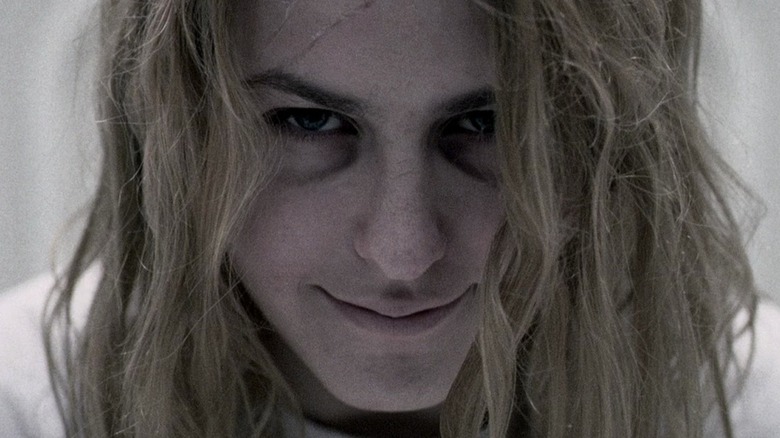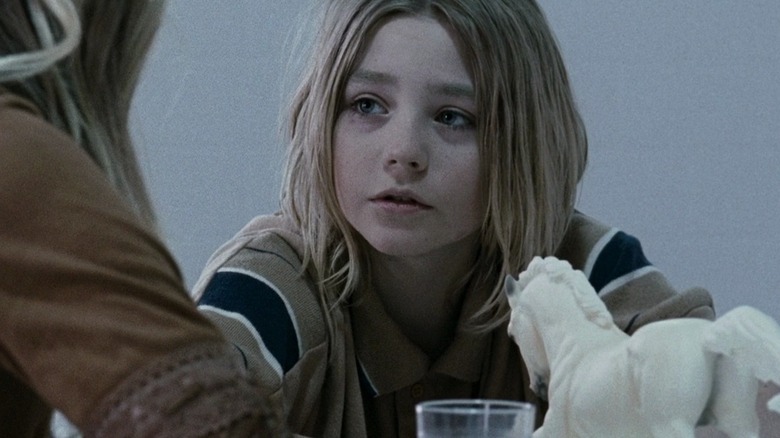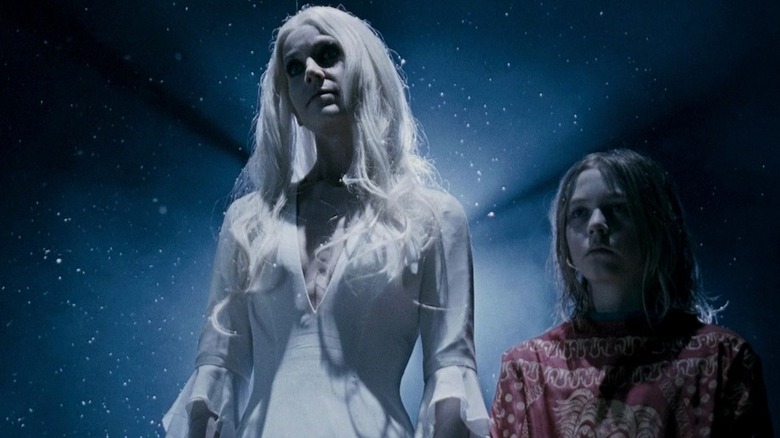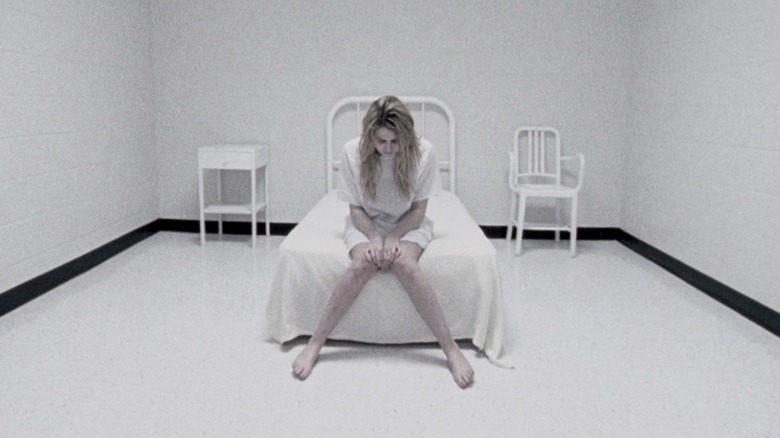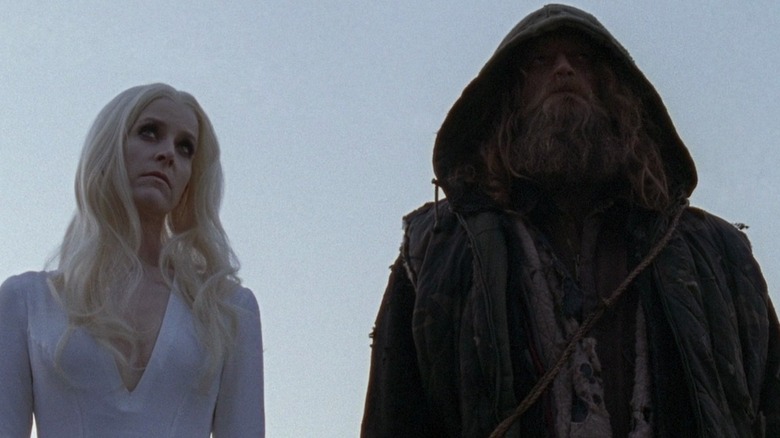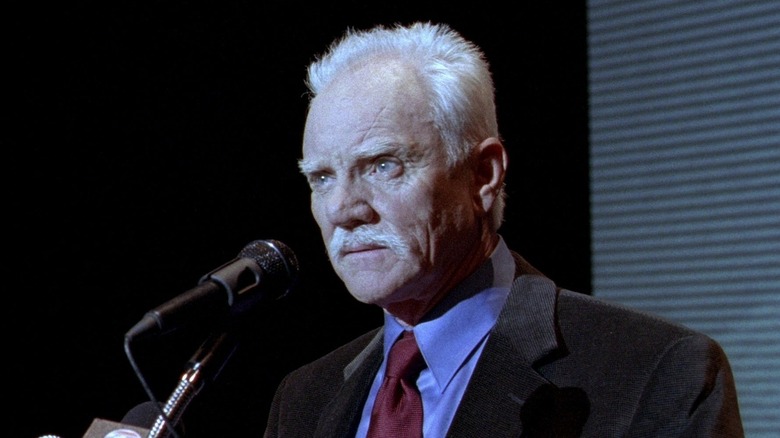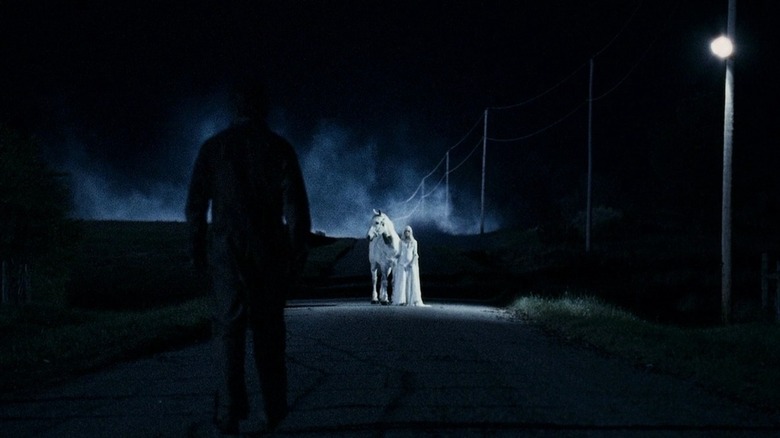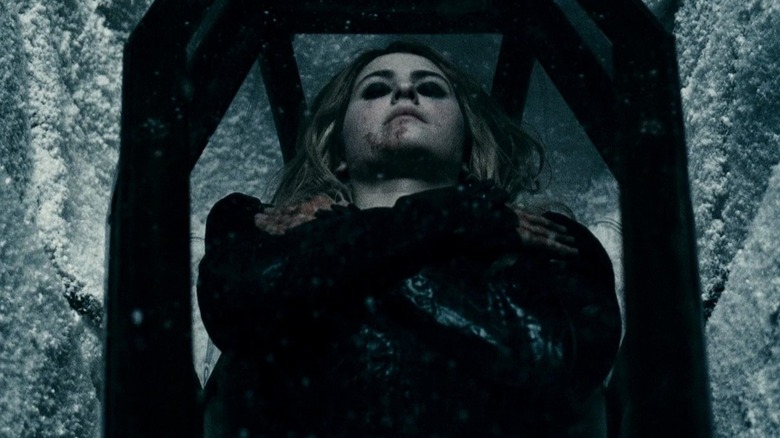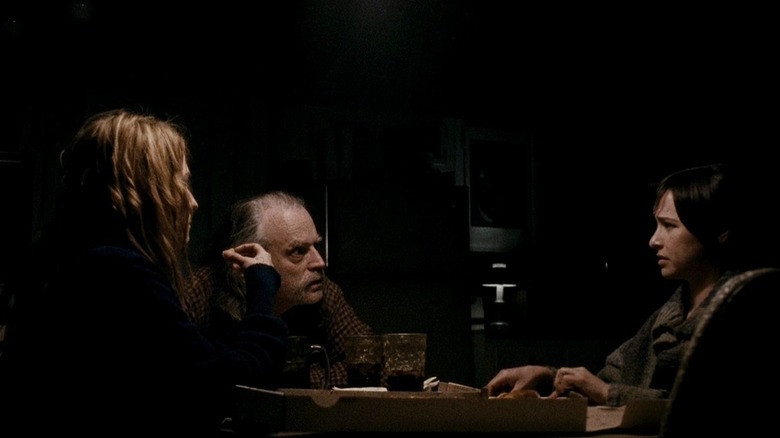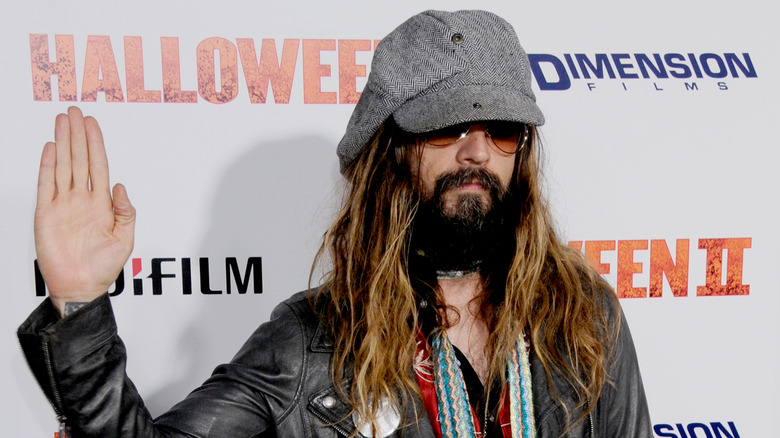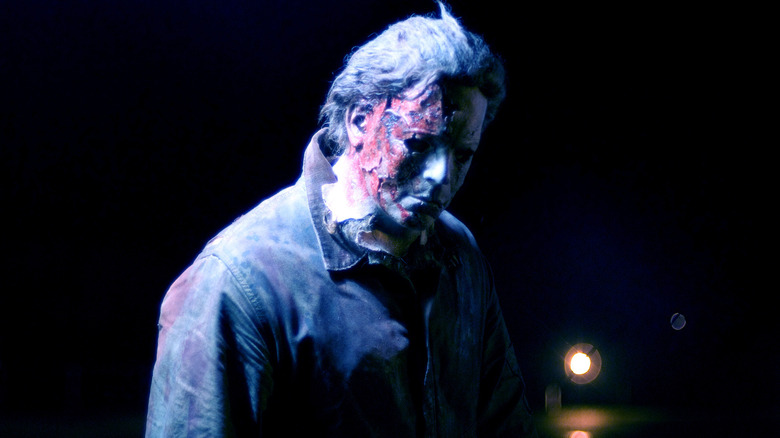The Ending Of Halloween II Explained
It may be hard to believe, but Michael Myers has been terrifying moviegoers for well over 40 years at this point. John Carpenter's original "Halloween" introduced the world to the now-infamous masked killer back in 1978. Since then, the franchise has grown to include over a dozen different movies and the entire "Halloween" story has become harder to track than just about any other horror series. Some post-Carpenter installments have been received enthusiastically by fans and critics, while others have fallen flat. One of the most memorable "Halloween" entries came from the mind of musician and filmmaker Rob Zombie.
In 2007, Zombie released his "Halloween" remake, and the sequel dropped in 2009. These movies spend more time exploring the backstory of Michael Myers. Zombie humanized the serial killer in a way that definitely didn't work for some audiences, but that nevertheless added a new level of depth to the character. From beginning to end, "Halloween II" is all about exploring the relationship between Michael Myers and Laurie Strode and showing how their trauma has linked them in unexpected ways. It's as blood-soaked as all the other "Halloween" movies, but it also leans pretty heavily on bizarre visions and obscure symbols. Here's what the ending of "Halloween II" is really trying to say.
What you need to remember about the plot of Halloween II
"Halloween II" picks up more-or-less where Rob Zombie's first remake left off. A brief flashback scene returns us to Michael Myers' childhood in Smith's Grove Sanitarium. We see his mother give him a white horse statue as a gift before we jump forward in time to catch up with the citizens of Haddonfield, Illinois, who are still reeling from Michael's violent rampage. After another quick diversion in the form of a dream sequence, the movie skips ahead to catch up with Laurie Strode one year after the events of "Halloween."
Laurie has a stable home life with Sheriff Brackett and his daughter Annie, but she's still struggling to deal with the trauma of what happened to her. She's plagued by nightmares and panic attacks. Other survivors aren't taking things so hard. Dr. Loomis has written a book about his relationship with Michael, and even though others question the morality of profiting from Michael's murders, Loomis has no qualms about living as a celebrity.
Everyone is finding their own way to move on after the events of the previous film, but as Halloween approaches, Michael (who managed to escape from the authorities after his murder spree) starts making his way back to Haddonfield. The closer he gets, the more Laurie seems to start experiencing the very same hallucinations that Michael has lived with for years. Michael begins a new killing spree, and Laurie unwittingly walks right into his path.
What happened at the end of Halloween II?
It's Halloween night in Haddonfield, and Michael Myers is on the loose. Michael seems to be looking for Laurie, but he encounters and cuts down plenty of other townspeople on his way to her. Eventually, Michael winds up at Sheriff Brackett's house, but earlier that night Laurie left home after making a horrifying discovery: She's Michael's biological sister. The only person home is Sheriff Brackett's daughter Annie, who Michael doesn't hesitate to kill.
Of course, it's only a matter of time before Michael finds Laurie, but when the two come face to face, something strange happens. After getting knocked unconscious, Laurie wakes up in an abandoned shack and she sees their mother standing next to a younger version of Michael. Laurie's hallucinations grab her and hold her in place while police swarm outside. Suddenly feeling guilty about his profiteering, Dr. Loomis heads into the shack and tries to convince Laurie to move before Michael kills them both. Michael stabs and kills Loomis, then gets shot down by Sheriff Brackett.
Laurie can't seem to shake her hallucinations. She stands up and slowly moves towards Michael's body, but when she picks up his knife for herself, one of the officers standing outside fires on her. The movie fades to black and comes back in to show us Laurie sitting in a psychiatric ward. Laurie sees another hallucination of her mother walking toward her and grins at the camera just as the movie ends.
What the end of Halloween II means
"Halloween II" tries to say something about the different ways that people deal with trauma. Everyone in Haddonfield, even Dr. Loomis, is scarred by what happened in the first "Halloween," but no one goes about healing in the same way. Sheriff Brackett tries to throw himself into caring for Annie and Laurie. Annie just wants to push what happened out of her mind as much as possible and carry on with her life. Dr. Loomis tries to hide from his trauma by making a profit and living large.
Not everyone is dealing with their emotions in a healthy way, but Laurie is the only one who seems to have made no progress with her healing in the past year. In fact, the more time goes on, the worse Laurie seems to feel. It doesn't help that she discovers she's related to the very man who traumatized her, and that familial relationship actually ends up confusing the film's larger point about trauma.
Laurie and Michael share more than blood in this movie. They also experience the same hallucinations, and Laurie's seem even more potent than Michael's. At the climax, Laurie's hallucinations are so strong they prevent her from moving. The ending seems to imply that Michael's murderous nature has truly infected Laurie's own personality. It seems to say that, because they're related, they were always destined to lose their minds and become killers.
Where did Michael go for a year?
After giving us another glimpse into Michael's childhood, the movie returns to the end of Rob Zombie's "Halloween," but it does so in the most confusing way possible: What we see is a mixture of events that actually happened and things that are only playing out in Laurie's dream a year later. When the movie makes its dream sequence reveal, it's only natural to assume that everything you've just watched was imaginary, but that's not actually the case. The opening sequence shows us Michael escaping from custody, which actually happened, even though Laurie didn't know about it. The sequence also shows us Laurie and Annie being taken to the hospital. Those moments must have really happened, too — but in this instance they're part of Annie's dream.
Michael's attack on the hospital is entirely happening in Annie's nightmare, so it's safe to assume that the rest of the hospital shots are at least dream-tinged. In reality, Michael escaped custody, killing a paramedic in the process, and then proceeded to vanish as only he can. The implication is that Michael wanders the fields and forests surrounding Haddonfield — hiding from the authorities and interacting with his own hallucinations — for the next year. Michael only returns to Haddonfield because Halloween itself acts like a trigger that turns on his most violent impulses.
What does Dr. Loomis' role in the story actually mean?
Dr. Loomis gets plenty of screen time in "Halloween II," but his impact on the actual plot of the movie is subtle. Laurie accidentally learns about her heritage because of Loomis' book about Michael, and later she encounters the doctor himself in the shack with her killer brother. In that final scene, Loomis doesn't really get a redemption moment and mostly serves as one final target for Michael to brutalize before the movie ends. However, while Loomis may not be the most plot-centric character in "Halloween II," he still has an important role to play in the movie.
Loomis is basically a secondary antagonist for the film because of how he riles up the town and specifically sets off Laurie, causing her to leave things with Annie on bad terms right before her murder. Loomis and Laurie are actually the movie's best examples of how not to deal with trauma. Laurie feels personally at fault for what happened with Michael and takes too much of the blame on herself. Loomis, on the other hand, refuses to acknowledge that he had any role to play in Michael's murder spree and handles his trauma with an almost toxic positivity. By the end of the movie, it's clear that they both deserve sympathy, but neither of them should be role models for anyone.
Did Laurie and Michael have shared visions?
The hallucinations that Laurie and Michael experience throughout the movie are key to understanding what's going on at the end of "Halloween II." The flashback scene at the beginning of the movie lays the groundwork for what's happening in the hallucinations. Michael's mother gives him a white horse toy, and for him the horse comes to symbolize freedom and a path to a world where he and his mother can live in peace. Years later, he still envisions his mother and the horse leading him to a better life, despite her encouraging him to kill everyone he meets along the way.
Laurie has very similar hallucinations. She sees her mother and a younger version of Michael at multiple points throughout the movie. At times it might seem like this is an "Inception" situation, with Laurie and Michael literally sharing the same visions, but that's probably not what's really going on. In reality, both Laurie and Michael have visions that are related to their deepest fears. Michael is still living with his childhood fear of losing his mother, so he sees her everywhere he goes. Laurie is terrified of Michael, and as the tension in the movie ramps up, Laurie's visions become even more intense because her fear is becoming more real. The imagery in Laurie's hallucinations is pulled from her subconscious, which still remembers her mother and Michael as a young boy.
Does the ending have a supernatural element?
We've looked at the logical explanation for the hallucinations that Laurie and Michael have throughout the movie, but that's not the only way to explain them. It's easy to see even the hallucinations in the last scene of the movie as symbolic of either fear or trauma. However, if you look a little deeper, it seems as though there's a hint of the supernatural laced into them. Let's be honest: Michael Myers has always been a borderline supernatural villain. He has the ability to pop up just about anywhere without making a sound, and no matter what kind of injuries he sustains, nothing seems to kill him. The visions could be just another manifestation of Michael's strange powers, one that he can't control directly.
Looking at the visions as a supernatural manifestation of Michael's evil makes the ending of the movie even darker. From this perspective, the moment that Laurie goes to pick up Michael's knife is a hint that some part of him has taken over her. Laurie might not necessarily have Michael's consciousness inside her, but his evil has infected her through the visions and is compelling her to start killing. Laurie's smile in the psychiatric ward when she once again sees her mother approaching is a sign that she's embracing her fate. It appears as though she's getting ready to make her escape and go on a killing spree of her own.
What happens to Laurie now?
"Halloween II" leaves Laurie in a psychiatric facility, but it doesn't really hint about what will happen to her next. Her fate largely depends on your interpretation of the ending. If Laurie has become a pseudo Michael Myers, then she'll probably escape her room at some point and start killing people in the area. She's just about ready to take over the family business, so to speak. However, if she's just deeply traumatized by everything that's happened to her in the past year, then there's still some small chance for a happy ending. After all, just because Laurie's brother never managed to make a successful recovery from his own traumatic past doesn't necessarily mean that all hope is lost for her.
One person has thought about Laurie's future a bit more than anyone else. Screenwriter Todd Farmer was hired to write the sequel to "Halloween II," then titled "Halloween 3D." Farmer's movie never got made, but he told Bloody Disgusting all about what would have happened in it had the sequel made it to the screen. In Farmer's version of events, Laurie does briefly go down Michael's path. She kills Loomis and Sheriff Brackett, but she can't live with what she's done. In his silent way, Michael tries to encourage her to embrace her more violent nature. Laurie struggles with her impulses for a while, but in the end she all but begs Michael to kill her because she can't follow his path. The movie definitely would have made for a grim conclusion to Rob Zombie's time at the "Halloween" helm.
What has Rob Zombie said about the film?
Rob Zombie had some big shoes to fill when he took on the "Halloween" reboot. Even just making a sequel to a beloved movie can be stressful, but the process of recreating a classic while also throwing in new elements had to have been especially exhausting creatively. To hear Zombie tell it, the most stressful part about making "Halloween" had less to do with the franchise's legacy and more with the communication between himself and the producers. "Making 'Halloween' with the Weinsteins was a miserable experience for me," Zombie told Forbes. According to the director, he never felt that he had the trust of the producers, and they constantly questioned all of his decisions.
Zombie somewhat reluctantly decided to jump on board for "Halloween II," and though that movie didn't prove to be any less taxing, he really enjoyed what it became. "I am still proud of both 'Halloween' movies," Zombie told Revolver before going on to reveal which one he likes best: "I prefer the second one, which might surprise people." Zombie explained that because his first movie could never escape the shadow of the original "Halloween" — which is without a doubt one of the greatest horror movies of all time — the audience could get a clearer sense of what he was going for in the sequel.
Whatever happened to Halloween III?
Even without Rob Zombie, who ruled himself out of returning to the director's chair, Dimension Films still planned to go ahead with another "Halloween" film, but "Halloween III" (or "Halloween 3D," as it was briefly titled) never came to pass. In the Todd Farmer-penned sequel, we were going to see things from Laurie's point of view. "The first ten minutes of the movie, it was in 2D," he explained to Bloody Disgusting. "Then when [Laurie] takes the mask off, and we see through her point of view, the whole world goes into 3D."
That wasn't the only idea the studio considered: For a time there were even talks of transforming "Halloween III" into a found footage horror. The found footage idea didn't take hold, but neither did Farmer's initial script. Production on the movie dragged out until 2015, when Dimension Films lost the rights to the "Halloween" franchise altogether. Dimension's run on the series began with 1995's "Halloween: The Curse of Michael Myers," which kicked off a trend of new "Halloween" entries that failed to impress.
Luckily for fans, that isn't the end of the story. Rob Zombie's "Halloween" series never became a trilogy, but the franchise as a whole — much like its serial killer — just wouldn't stay dead. Eventually, Blumhouse, Miramax, and Trancas International Films came together to produce 2018's "Halloween." That began a brand new trilogy within the franchise and made it even more difficult to figure out the correct order to watch the "Halloween" movies.
